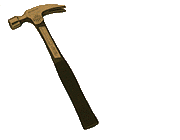
|
Now that the festive Expo season is over for another year, we can again turn our attention to those household projects we put on hold over Expotide. But which project? In trying to determine this month's subject, it occurred to me that I've made a ghastly mistake; put the cart before the horse so to speak. What's the most important aspect of any home improvement project? What's the first thing that must be determined before any do-it-yourself project can even be contemplated? Why, the type of beer you're going to drink when the project is over of course! Bud-Miller, or some other American lawn mower beer? Uninspired. Microbrewed American or imported yuppie beer? Good, but pricey, and we work for the PTO, so that's out. Now the whole point of this column is empowerment, self reliance and quality. But it doesn't always make sense to do things yourself. You could quite easily make your own soap on the kitchen stove, but why bother when the soap at the store is just fine and it's inexpensive? And it would probably be a big mistake for me to try and build my next car. But you can make beer at home that is better and less expensive than the beer at the store, and it's kind of fun to do. "Beer" is the generic name for any fermented grain beverage. Many anthropologists believe that agriculture, and hence civilization itself, arose because of our ancient ancestors' desire for a constant supply of beer. We can imagine the discovery of beer: a few bowls of barley gruel are left outside the cave for a few days in the rain while the family was out hunting and gathering. Upon the family's return, they are discovered and found to be a bit bubbly, but times being what they were, the family drank/ate the contents and soon felt a mysterious inner peace coupled with the strange desire to sit in a La-Z-Boy chair and watch something called football. Civilization marches on. There are many ways to make beer, and technique will affect the way the beer tastes. But far and away the most important thing to remember about making beer is KEEP IT CLEAN. A solution made of a tablespoon of household bleach in a gallon of water will kill any living organism on your equipment that could live in your beer and affect the flavor (there is no pathogen that can live in the alkaline environment of beer; no matter how badly you screw it up, your beer can't hurt you). So anything that comes in contact with the beer after it is boiled should be soaked in this bleach solution before it comes in contact with your beer.
To brew 4-5 gallons of beer you'll need the following:
To make your first batch of beer, you'll need these ingredients that will produce a good, easy to make ale: Here's what you do: Dissolve the malt extract in 2 gallons of water and bring it to a boil for a half hour or more. If you like a more pronounced hop taste (like Beck's or some Canadian beer) add 1/2 oz. of hops in the last 10 minutes of the boil. Sanitize your plastic fermenter with a weak bleach and water solution. Add 3 gallons of clean, cold water to your clean fermenter. If you're using tap water, it's best to have boiled this water a day or two beforehand thus sterilizing it, let it cool, and store it in sanitized plastic milk jugs, or perhaps the sanitized fermenter itself. Add the hot malt and water to the fermenter. You should have 5 gallons of liquid, top up if necessary. Let cool to below 80 degrees, measure the gravity with the hydrometer and add the yeast. Put the sanitized cover and fermentation lock on. In 2 days or so, when the initial frothy fermentation is over, siphon the beer off the yeast and trub at the bottom using the sanitized plastic hose. Trub is malt proteins from the fermentation process Syphon it into the sanitized carboy and put in the rubber cork and fermentation lock. Let the beer ferment and clear for 8 to 14 days (or whenever the hydrometer indicates that fermentation is over). Syphon the clear beer off the yeast and trub again into the sanitized plastic fermenter addin 3/4 cup of corn sugar that you have boiled in a cup or two of water to sterilize it. Then syphon the beer into sanitized beer bottles and cap them. Age the beer for 10 days or more and drink the beer. You can get the ingredients at homebrew and winemaking shops in the area. Look in the Yellow Pages under "Beer Homebrewing Equipment and Supplies." There are also hundreds of mail order companies which advertise in the excellent publication "Zymurgy" available at some of the homebrew shops or from P.O. Box 1679, Boulder, Co. 80306. (303) 447-0816. Probably the best book on homebrewing is "The Complete Joy of Homebrewing" by Charlie Papazian, and is available in libraries and at most bookstores. That about does it for this month; now it's Miller time. Next month: Home steel making.
|